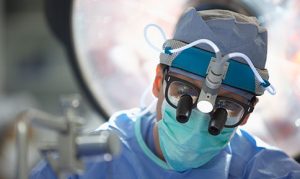 Microtia is a birth defect that occurs when the external ear (pinna) is underdeveloped. Microtia occurs once in every 8,000–10,000 births. Causes include genetic factors and environmental factors such as a possible side effect of the acne treatment drug Accutane (isotretinoin) if taken by mothers during pregnancy.
Microtia is a birth defect that occurs when the external ear (pinna) is underdeveloped. Microtia occurs once in every 8,000–10,000 births. Causes include genetic factors and environmental factors such as a possible side effect of the acne treatment drug Accutane (isotretinoin) if taken by mothers during pregnancy.
Types of Microtia
A completely undeveloped external ear is called microtia-anotia. If only one side is affected, it’s referred to as unilateral microtia. This most commonly affects the right ear. If it affects both sides then it is called bilateral microtia.
Microtia is graded on a four point scale, with Grade I microtia being the mildest form and Grade IV the most severe:
- Grade I: Incomplete development of the external ear, identifiable ear structures, small external ear canal.
- Grade II: Partial ear development, closed external ear canal, conductive hearing loss.
- Grade III: No external ear, small peanut-like vestige structure, no external ear canal, no ear drum. This is the most common form of microtia.
- Grade IV: Completely undeveloped ear. Referred to as anotia or microtia-anotia.
Microtia Treatment Options
Other Outer Ear Deformities
Ear deformities include the absence or underdevelopment of ear cartilage, prominent ears, constricted ears and everything in between. Prominent ears are ears that project out from the head further than normal, while a constricted ear occurs when a portion of ear cartilage is missing and makes the ear have a lid-like appearance. Others with deformed ears might have been the victim or a dog bite attack, with a portion or the entire ear having been ripped off.
The good news is that our facial plastic surgeons perform reconstructive ear surgery to correct many of these deformities, including microtia. The goal is to provide the best form and function to the underdeveloped ear. In addition to hopefully improving patients’ hearing, reconstructive ear surgery gives people a chance to have a normal looking ear. Children who suffer from the self-esteem issues that come with an underdeveloped external ear may benefit psychologically from reconstructive ear surgery. The same goes for adults who might find microtia a source of embarrassment, self-consciousness, or shame.
What Is Otoplasty?
Otoplasty is a simple and effective surgical procedure on the ear. The whole process takes just a matter of hours and can be performed on anyone once the ears have reached full size (usually around five or six years of age). A minor difference in surgical outcomes between adults and children, firmer ear cartilage of fully developed ears in adults will not mold quite as easily as the more pliable ear cartilage in children.
Otoplasty begins with a surgical incision behind the ear located in the natural fold where the ear meets the head. Ear cartilage and skin is then molded to create an ideal ear structure. Sutures will be added to hold the new ear shape in place in some but not all patients. Immediately following ear surgery, dressings are applied to aid in healing and comfort. The ear will be left to heal naturally into the desired position, and the scar will be hidden in the natural crease behind the ear.
Contact Our Los Angeles Facial Plastic Surgeons
If you are interested in a cosmetic or reconstructive procedure, please call us at (855) 360-9119 and ask to speak with the Department of Plastic & Reconstructive Surgery or email us at [email protected]. Dr. Carlo P. Honrado, a facial plastic surgeon, performs many otoplasty and ear surgery procedures. He is double board-certified in Facial Plastic and Reconstructive Surgery and Head & Neck Surgery.
To learn more about otoplasty in Beverly Hills, don’t hesitate to contact us today!
For more detailed information about microtia and the treatment options we offer at La Peer, please visit our Ear Surgery Center of Excellence website.
Next, read about Rhinoplasty.
